Publications
Please don’t hesitate to reach out if you need access to a paper. Scientific articles are often locked behind paywalls, but I am happy to provide a PDF version. * - Equal contributions. † - Undergraduate mentee. ‡ - Graduate mentee.
Recent Publications
M.C. Sasaki, A. Rodger†, C. Saratkar†, J. Cull-Host†, S. Sharp† & M. Pespeni (2025) “A high-resolution physiological timeseries uncovers strong but variable seasonal acclimation of thermal limits in a copepod community”.
How a community responds to warming depends on both intra-specific variation in thermal limits and variation in acclimation capacity across community members. These factors, however, are often overlooked, leading to uncertainties about how climate change affects biodiversity. In temperate regions, communities are exposed to large seasonal temperature fluctuations, providing an opportunity to examine community-wide effects of acclimation under natural conditions. Using a weekly physiological time series, we examined seasonal variation in upper thermal limits for the entire community of calanoid copepods in Lake Champlain, a large and highly seasonal lake in North America. Thermal limits varied substantially between species, with winter-dominant species having lower thermal limits than summer-dominant species. Our high-resolution temporal data also revealed substantial but variable acclimation capacities across community members. Hindcasted vulnerability estimates highlight the importance of species-specific estimates of acclimation capacity for robust predictions about the impacts of warming. Over the course of our collections, we also recorded two novel species occurrences in Lake Champlain, both of which were notable for their high upper thermal limits. Our results highlight the importance of acclimation in shaping population responses to temperature variation under natural conditions.
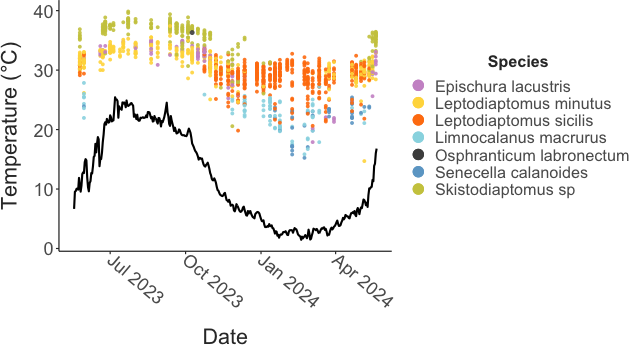
Sasaki, M.C.*, Isanta-Navarro, J.*, & Govaert, L.* (2025) “Experimental ecology and the balance between realism and feasibility in aquatic ecosystems”. Nature Communications, 16, 5142.
Experimental research, ranging from fully-controlled laboratory experiments to semi-controlled field manipulations, enhances our understanding of the mechanisms underlying natural dynamics and species responses to global change. These approaches, many of which were first developed in aquatic systems, have laid the foundations for modern ecological work. In this Perspective, we discuss how aquatic experimental ecology has shaped the field of ecology and how modern experimental ecology has contributed to our understanding of ecological dynamics under changing conditions in aquatic systems. We also highlight the challenges experimental ecologists must overcome in the near future as we seek to predict and mitigate the effects of global change. We argue that many of the challenges we currently face can be overcome by embracing multidimensional ecological experiments, moving beyond classical model organisms, including environmental variability, integrating across disciplinary boundaries and using novel technologies.
Vermandele, F., E. Roy, M.C. Sasaki, G. Winkler, H.G. Dam, P. Calosi & D. Madeira (2025) “You are on your own, kid: parental effects impair a ubiquitous copepod’s ability to recover from extreme events”. Marine Environmental Research, 210, 107286.
Parental environments can positively or negatively influence offspring phenotypes through non-genetic inheritance known as parental effects. Our understanding of these mechanisms across generations during simultaneous extreme events, such as marine heatwaves (MHW) and hypoxia, is however very limited. This is particularly true when parents and offspring experience highly contrasting environments. Additionally, the potential for females and males to show contrasting responses to these parental effects is largely overlooked. Our study tested the recovery potential of the cosmopolitan and highly abundant copepod Acartia tonsa, following parental exposure to hypoxia and MHW. Parents (F1) were exposed for five days to the isolated or combined effects of hypoxia and MHW. Following hatching, their offspring (F2) were returned to control conditions for the rest of their life cycle. Copepods’ survival, prosome length, metabolic rate and heat tolerance were measured in adult males and females (F1-F2) to assess the effect of parental exposure on offspring’s sex-specific life-history and physiological performances when adult. Reaction norms between the two generations reveal that the direction of changes in the F2 phenotypes was treatment-dependent and sex-specific. Strong negative carry-over effects were also observed for all traits, with the exception of metabolic rates, following parental exposure to the MHW condition in isolation. Our results highlight the need to investigate in depth the long-lasting effects of extreme events, as the legacy of stress we report here could limit species’ ability to recover from successive MHW events and impact species persistence in a changing ocean.
2024
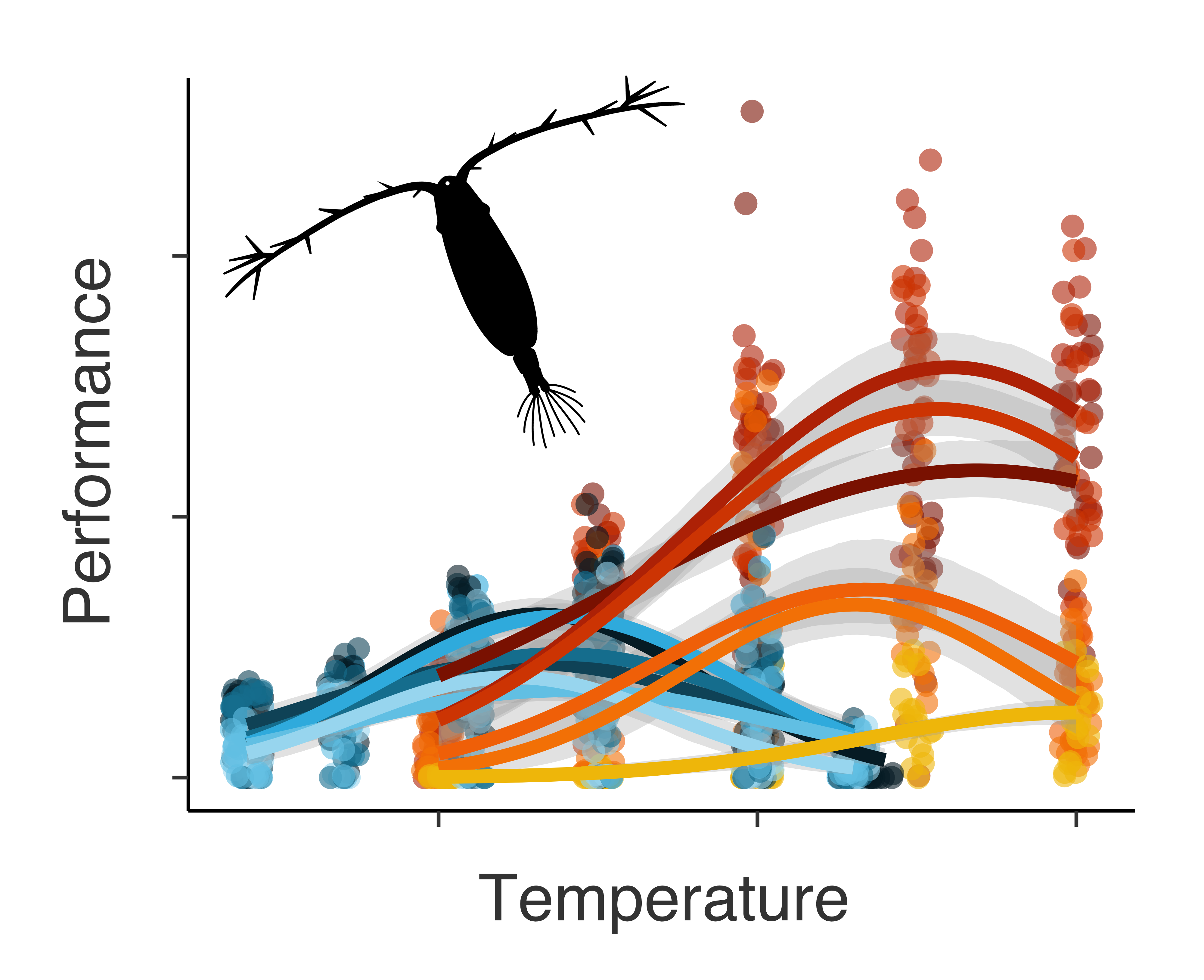
Sasaki, M. C., M. Finiguerra, & H. G. Dam (2024) Seasonally variable thermal performance curves prevent adverse effects of heatwaves. Journal of Animal Ecology, 94, 1542–1552.
The increasing frequency and intensity of heatwaves may represent a significant challenge for predicting vulnerability of populations in a warming ocean. The direct impacts of heatwaves on populations depend on the relative position of environmental temperatures to the thermal performance curve optima. If thermal performance curves are static, the effects of heatwaves may therefore change seasonally over the annual temperature cycle. However, these seasonal changes in the effects of heatwaves may be dampened by corresponding variation in thermal performance curves which, in organisms with relatively short generation times, may be driven by phenotypic plasticity as well as genetic differentiation. Here we investigate the effects of seasonal timing and duration on the impacts of heatwaves in the ecologically important copepod congeners Acartia tonsa and Acartia hudsonica, and test the hypotheses that 1) seasonal variation in thermal performance curves will reduce overall population vulnerability to heatwaves, and 2) that seasonal variation in TPCs will prevent negative transgenerational effects of heatwave. We characterized seasonal variation in thermal performance curves for several fitness-related traits. These experiments uncovered strong seasonal variation in the thermal performance curves of Acartia tonsa, and indicate that this variation buffers against negative effects of simulated heatwaves. We also quantified both direct and trans-generational effects of different duration heatwaves on copepods collected at various times throughout the season using simulated heatwave experiments. There was no consistent pattern in the transgenerational effects of parental exposure to heatwaves, which may indicate that seasonal variation in thermal performance curves reduces the effects of parental stress on offspring performance. Our results show that seasonal variation in thermal performance curves will likely play an important role in limiting the adverse effects of heatwaves on populations.
Griffiths, J.*, M.C. Sasaki*, I. Neylan, & M. Kelly (2024) Experimental Evolution: A powerful tool to understand trade-offs and genomic architecture during rapid evolution. Global Change Biology, 30, e17584.
Evolutionary responses to climate change may incur trade-offs due to energetic constraints and mechanistic limitations, which are both influenced by environmental context. Adaptation to one stressor may result in life history trade-offs, canalization of phenotypic plasticity, and the inability to tolerate other stressors, among other potential costs. While trade-offs incurred during adaptation are difficult to detect in natural populations, experimental evolution can provide important insights by measuring correlated responses to selection as populations adapt to changing environments. However, studies testing for trade-offs have generally lagged behind the growth in the use of experimental evolution in climate change studies. We argue that the important insights generated by the few studies that have tested for trade-offs make a strong case for including these types of measurements in future studies of climate adaptation. For example, there is emerging consensus from experimental evolution studies that tolerance and tolerance plasticity trade-offs are an often observed outcome of adaptation to anthropogenic change. In recent years, these types of studies have been strengthened by the use of sequencing of experimental populations, which provides promising new avenues for understanding the molecular mechanisms underlying observed phenotypic trade-offs.
Vermandele, F., M.C. Sasaki, G. Winkler, H.G. Dam, D. Madeira, P. & Calosi (2024) “Sex-specific physiological responses to the simultaneous exposure to hypoxia and marine heatwave events”. Global Change Biology, 30, e17553.
The existence of sex-specific differences in phenotypic traits is widely recognised. Yet they are often ignored in studies looking at the impact of global changes on marine organisms, particularly within the context of combined drivers that are known to elicit non-linear responses. We tested sex-specific physiological responses of the cosmopolitan and ecologically important marine copepod Acartia tonsa exposed to combined hypoxia and marine heatwave (MHW) conditions; both of which individually strongly affect marine ectotherms. Females and males were acutely exposed for 5-d to a combination of either control (18 °C) or a high temperature mimicking a MHW (25 °C), and normoxia (100 % O2 sat.) or hypoxia (35 % O2 sat.). Survival, life-history traits and sex-specific physiological traits were measured. Females had overall higher thermal tolerance levels and responded differently than males when exposed to the combined global change drivers investigated. Females also showed lower metabolic thermal sensitivity when compared to males. Additionally, the MHW exerted a dominant effect on the traits investigated, causing a lower survival and higher metabolic rate at 25 °C. However, egg production rates appeared unaffected by hypoxia and MHW conditions. Our results showed, that MHWs could strongly affect copepods’ survival, that exposure to hypoxia partly buffers MHW impacts, and that sex-specific vulnerability to these global change drivers could have major implications for population dynamics. Our results highlight the importance of considering the differences in the responses of females and males to rapid environmental changes, to improve the implementation of climate-smart conservation approaches.
Selden, C. R.* R. LaBrie*, L. C. Ganley*, D. R. Crocker, O. Peleg, D. Perry, H. G. Reich, M. C. Sasaki, P. S. Thibodeau & J. Isanta-Navarro (2024) Is our understanding of aquatic ecosystems sufficient to quantify ecologically-driven climate feedbacks? Global Change Biology, 30, e17351.
The Earth functions as an integrated system—its current habitability to complex life is an emergent property dependent on interactions among biological, chemical and physical components. As global warming affects ecosystem structure and function, so too will the biosphere affect climate by altering atmospheric gas composition and planetary albedo. Constraining these ecosystem-climate feedbacks is essential to accurately predicting future change and developing mitigation strategies; however, interplay among ecosystem processes complicates assessment of their impact. Here, we explore the state of knowledge on how ecological and biological processes (e.g., competition, trophic interactions, metabolism, adaptation) affect the directionality and magnitude of feedbacks between ecosystems and climate, using illustrative examples from the aquatic sphere. We argue that, despite ample evidence for the likely significance of many, our present understanding of the combinatorial effects of ecosystem dynamics precludes the robust quantification of most ecologically-driven climate feedbacks. Constraining these effects must be prioritized within the ecological sciences for only by studying the biosphere as both subject and arbiter of global climate can we develop a sufficiently holistic view of the Earth system to accurately predict Earth’s future and unravel its past.
2023
Rueda Moreno, G.† & M. C. Sasaki (2023) Starvation reduces thermal limits of the widespread copepod Acartia tonsa. Ecology and Evolution, 13, e10586.
Organismal thermal limits affect a wide range of biogeographical and ecological processes. Copepods are some of the most abundant animals on the planet, and play key roles in aquatic habitats. Despite their abundance and ecological importance, there is limited data on the factors that affect copepod thermal limits, impeding our ability to predict how aquatic ecosystems will be affected by anthropogenic climate change. In a warming ocean, one factor that may have particularly important effects on thermal limits is the availability of food. A recently proposed feedback loop known as “metabolic meltdown” suggests that starvation and exposure to high temperatures interact to drastically reduce organismal thermal limits, increasing vulnerability to warming. To investigate one component of this feedback loop, we examined how starvation affects thermal limits (critical thermal maxima: CTmax) of Acartia tonsa, a widespread estuarine copepod. We found that there was no effect of short duration exposure to starvation (up to two days). However, after three days, there was a significant decrease in the CTmax of starved copepods relative to the fed controls. Our results provide empirical evidence that extended periods of starvation reduce thermal limits, potentially initiating “metabolic meltdown” in this key species of coastal copepod. This suggests that changes in food availability may increase vulnerability of copepods to increasing temperatures, amplifying the effects of climate change on coastal systems.
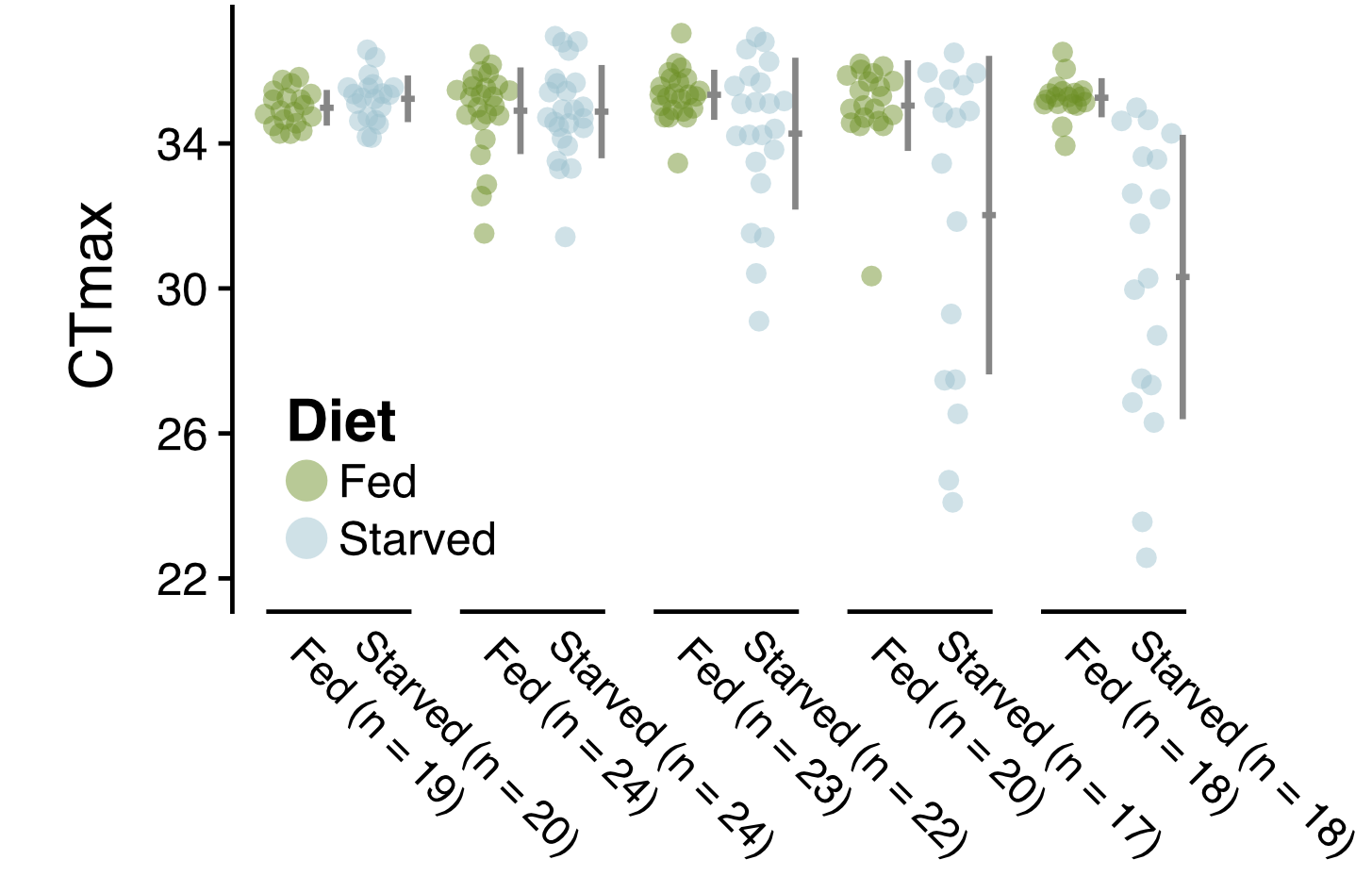
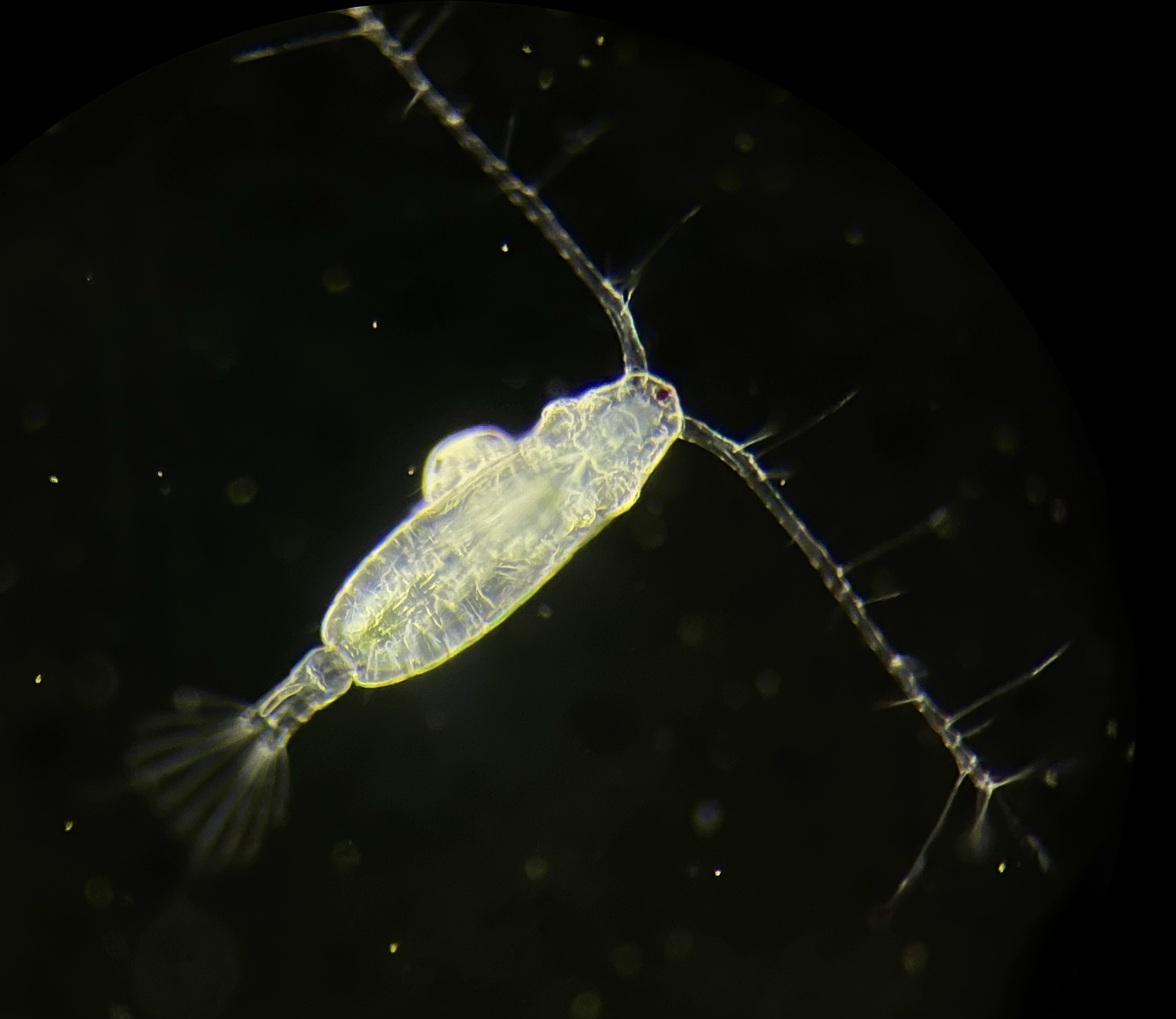
Sasaki, M. C., C. Woods, & H.G. Dam (2023) Parasitism does not reduce thermal limits in the intermediate host of a bopyrid isopod. Journal of Thermal Biology, 117, 103712.
Parasitism has strong effects on community dynamics. Given the detrimental effects parasites have on host health, infection or infestation might be expected to reduce upper thermal limits, increasing the vulnerability of host species to future climate change. Copepods are integral components of aquatic food webs and biogeochemical cycles. They also serve as intermediate hosts in the life cycle of parasitic isopods in the family Bopyridae. Given the important effects both copepods and isopod parasites play in aquatic communities, it is important to understand how the interaction between parasite and host affects thermal limits in order to better predict how community dynamics may change in a warming climate. Here we examined the effect of infestation by larvae of a bopyrid isopod on cosmopolitan copepod Acartia tonsa to test the hypothesis that infestation reduces thermal limits. To aid with this work, we developed an affordable, highly portable system for measuring critical thermal maxima of small ectotherms. We also used meta-analysis to summarize the effects of parasitism on critical thermal maxima in a wider range of taxa to help contextualize our findings. Contrary to both our hypothesis and the results of previous studies, we observed no reduction of thermal limits by parasitism in A. tonsa. These results suggest that life history of the host and parasite may interact to determine how parasite infestation affects environmental sensitivity.
Holmes-Hackerd, M.‡, M. C. Sasaki, H. G. Dam (2023) Naupliar exposure to acute warming does not affect ontogenetic patterns in respiration, body size, or development time in the cosmopolitan copepod Acartia tonsa. PLOS One, 18(4), e0282380.
Short-term, acute warming events are increasing in frequency across the world’s oceans. For short-lived species like most copepods, these extreme events can occur over both within- and between-generational time scales. Yet, it is unclear whether exposure to acute warming during early life stages of copepods can cause lingering effects on metabolism through development, even after the event has ended. These lingering effects would reduce the amount of energy devoted to growth and affect copepod population dynamics. We exposed nauplii of an ecologically important coastal species, Acartia tonsa, to a 24-hour warming event (control: 18°C; treatment: 28°C), and then tracked individual respiration rate, body length, and stage duration through development. As expected, we observed a decrease in massspecific respiration rates as individuals developed. However, exposure to acute warming had no effect on the ontogenetic patterns in per-capita or mass-specific respiration rates, body length, or development time. The lack of these carryover effects through ontogeny suggests within-generational resilience to acute warming in this copepod species.
2022
Sasaki, M. C., J. Barley, S. Gignoux-Wolfsohn, C. Hays, M. Kelly, A. Putnam, S. Sheth, A. Villeneuve, & B. Cheng (2022) Greater local adaptation to temperature in the ocean than on land. Nature Climate Change, 12, 1175-1180.
There is considerable uncertainty regarding which ecosystems are most vulnerable to warming. Current understanding of organismal sensitivity is largely centred on species-level assessments that do not consider variation across populations. Here we used meta-analysis to quantify upper thermal tolerance variation across 305 populations from 61 terrestrial, freshwater, marine and intertidal taxa. We found strong differentiation in heat tolerance across populations in marine and intertidal taxa but not terrestrial or freshwater taxa. This is counter to the expectation that increased connectivity in the ocean should reduce intraspecific variation. Such adaptive differentiation in the ocean suggests there may be standing genetic variation at the species level to buffer climate impacts. Assessments of vulnerability to warming should account for variation in thermal tolerance among populations (or the lack thereof) to improve predictions about climate vulnerability.
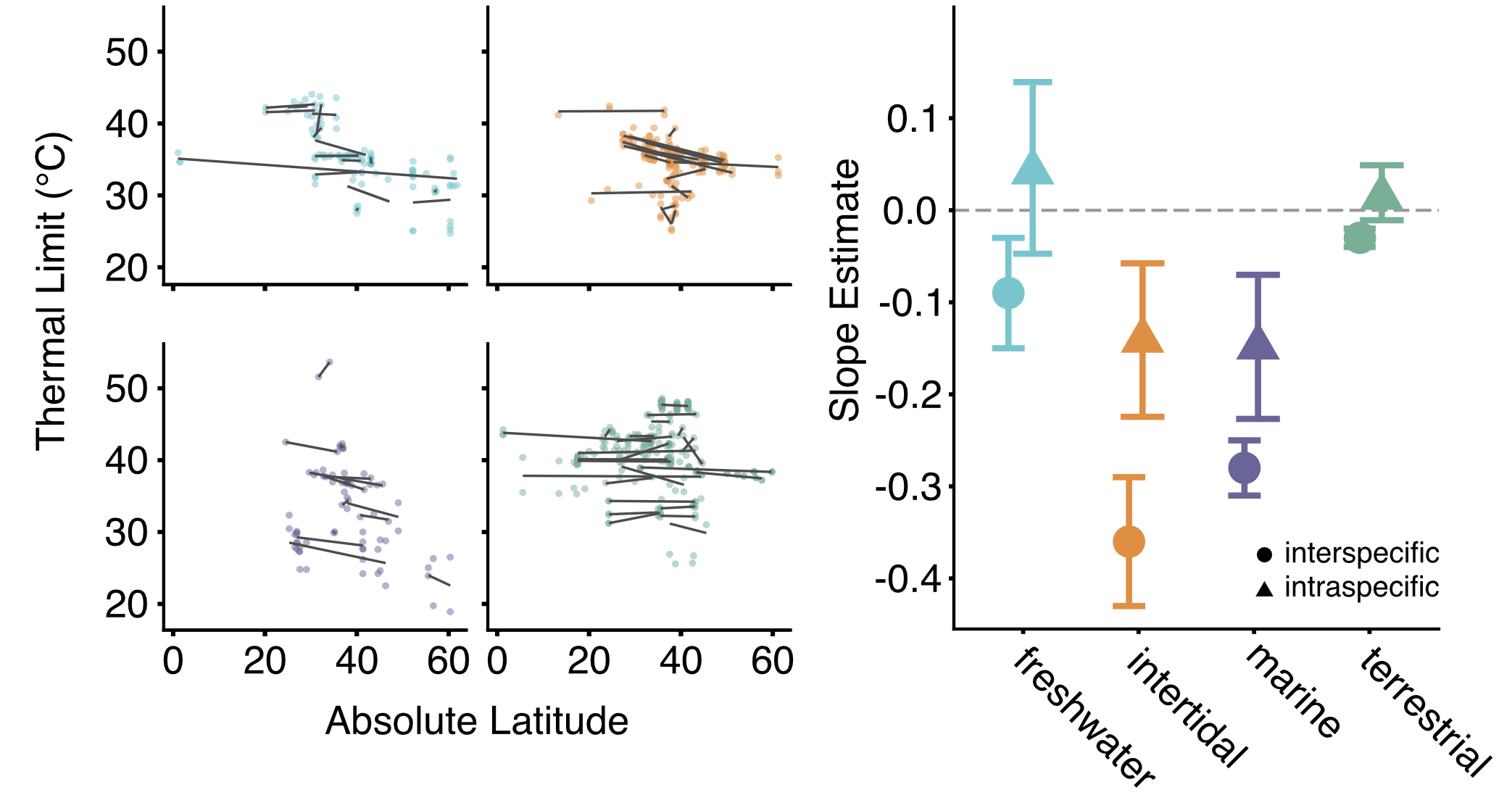
2021
Sasaki, M. C. & H. G. Dam (2021) Global patterns in copepod thermal tolerance. Journal of Plankton Research, 43(4), 598-609.
Copepods are key components of aquatic habitats across the globe. Understanding how they respond to warming is important for predicting the effects of climate change on aquatic communities. Lethal thermal limits may play an important role in determining responses to warming. Thermal tolerance can vary over several different spatial and temporal scales, but we still lack a fundamental understanding of what drives the evolution of these patterns in copepods. In this Horizons piece, we provide a synthesis of global patterns in copepod thermal tolerance and potential acclimatory capacities. Copepod thermal tolerance increases with maximum annual temperature. We also find that the effects of phenotypic plasticity on thermal tolerance are negatively related to the magnitude of thermal tolerance, suggesting a potential trade-off between these traits. Our ability to fully describe these patterns is limited, however, by a lack of spatial, temporal and phylogenetic coverage in copepod thermal tolerance data. We indicate several priority areas for future work on copepod thermal tolerance, and accompanying suggestions regarding experimental design and methodology.
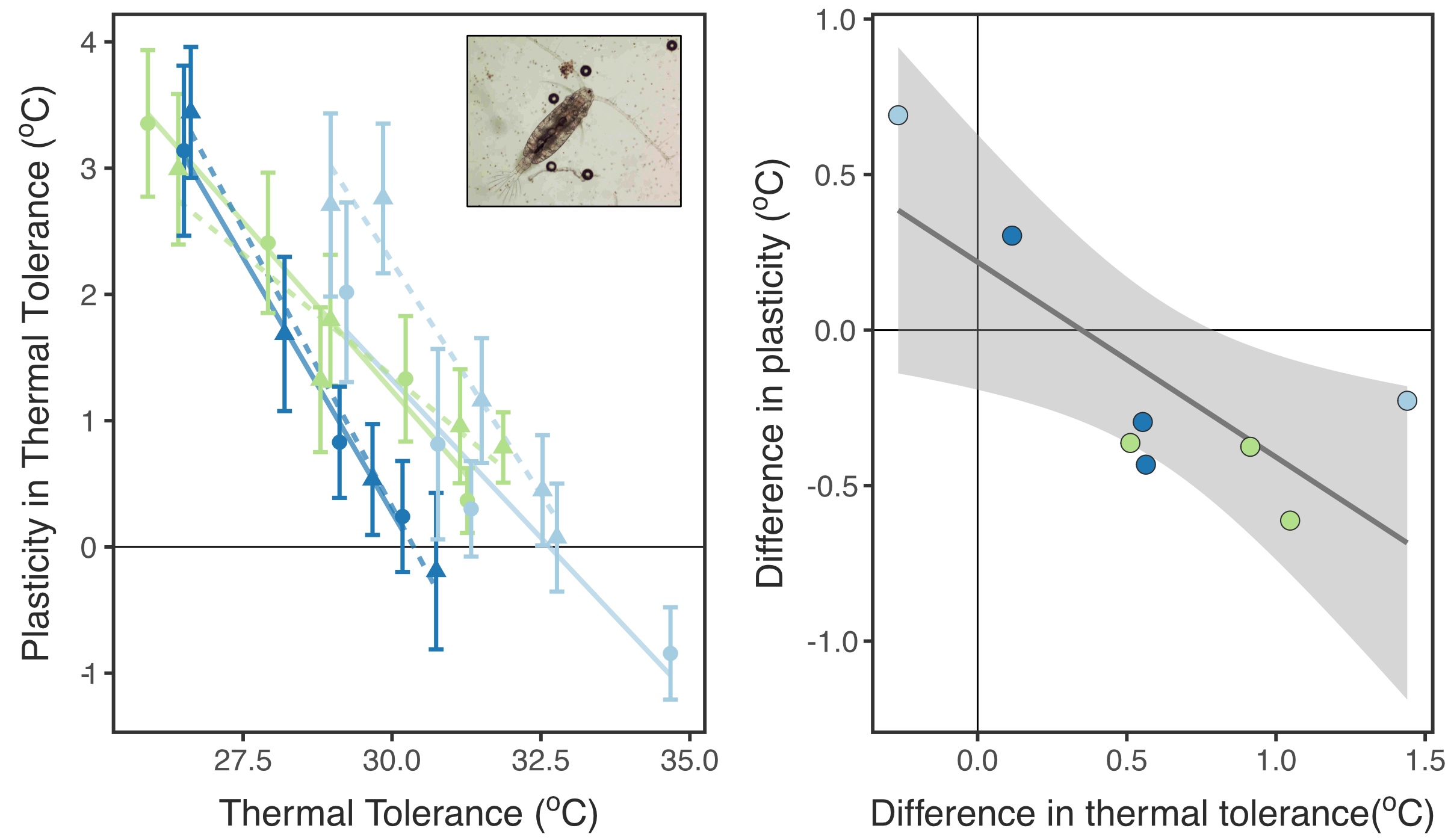
Sasaki, M. C. & H. G. Dam (2021) Negative relationship between thermal tolerance and plasticity in tolerance emerges during experimental evolution in a widespread marine invertebrate. Evolutionary Applications, 14(8), 2114-2123.
Whether populations can adapt to predicted climate change conditions, and how rapidly, are critical questions for the management of natural systems. Experimental evolution has become an important tool to answer these questions. In order to provide useful, realistic insights into the adaptive response of populations to climate change, there needs to be careful consideration of how genetic differentiation and phenotypic plasticity interact to generate observed phenotypic changes. We exposed three populations of the widespread copepod Acartia tonsa (Crustacea) to chronic, sublethal temperature selection for 15 generations. We generated thermal survivorship curves at regular intervals both during and after this period of selection to track the evolution of thermal tolerance. Using reciprocal transplants between ambient and warming conditions, we also tracked changes in the strength of phenotypic plasticity in thermal tolerance. We observed significant increases in thermal tolerance in the Warming lineages, while plasticity in thermal tolerance was strongly reduced. We suggest these changes are driven by a negative relationship between thermal tolerance and plasticity in thermal tolerance. Our results indicate that adaptation to warming through an increase in thermal tolerance might not reduce vulnerability to climate change if the increase comes at the expense of tolerance plasticity. These results illustrate the importance of considering changes in both a trait of interest and the trait plasticity during experimental evolution.
deMayo, J., A. Girod†, M. C. Sasaki & H. G. Dam (2021) Adaptation to simultaneous warming and acidification carries a thermal tolerance cost in a marine copepod. Biology Letters, 17(7), 20210071.
The ocean is undergoing warming and acidification. Thermal tolerance is affected both by evolutionary adaptation and developmental plasticity. Yet, thermal tolerance in animals adapted to simultaneous warming and acidification is unknown. We experimentally evolved the ubiquitous copepod Acartia tonsa to future combined ocean warming and acidification conditions (OWA approx. 22°C, 2000 µatm CO2) and then compared its thermal tolerance relative to ambient conditions (AM approx. 18°C, 400 µatm CO2). The OWA and AM treatments were reciprocally transplanted after 65 generations to assess effects of developmental conditions on thermal tolerance and potential costs of adaptation. Treatments transplanted from OWA to AM conditions were assessed at the F1 and F9 generations following transplant. Adaptation to warming and acidification, paradoxically, reduces both thermal tolerance and phenotypic plasticity. These costs of adaptation to combined warming and acidification may limit future population resilience.
Barley, J. M., B.S. Cheng, M. C. Sasaki, S. Gignoux-Wolfsohn, C.G. Hays, A.B. Putnam, S. Sheeth, A.R. Villeneuve, & M.W. Kelly (2021) Limited plasticity in thermally tolerant ectotherm populations: evidence for a trade-off. Proceedings of the Royal Society B: Biological Sciences, 288(1958), 288:20210765.
Many species face extinction risks owing to climate change, and there is an urgent need to identify which species' populations will be most vulnerable. Plasticity in heat tolerance, which includes acclimation or hardening, occurs when prior exposure to a warmer temperature changes an organism's upper thermal limit. The capacity for thermal acclimation could provide protection against warming, but prior work has found few generalizable patterns to explain variation in this trait. Here, we report the results of, to our knowledge, the first meta-analysis to examine within-species variation in thermal plasticity, using results from 20 studies (19 species) that quantified thermal acclimation capacities across 78 populations. We used meta-regression to evaluate two leading hypotheses. The climate variability hypothesis predicts that populations from more thermally variable habitats will have greater plasticity, while the trade-off hypothesis predicts that populations with the lowest heat tolerance will have the greatest plasticity. Our analysis indicates strong support for the trade-off hypothesis because populations with greater thermal tolerance had reduced plasticity. These results advance our understanding of variation in populations' susceptibility to climate change and imply that populations with the highest thermal tolerance may have limited phenotypic plasticity to adjust to ongoing climate warming.
2020
Sasaki, M. C. & H. G. Dam (2020) Genetic differentiation underlies seasonal variation in thermal tolerance, body size, and plasticity in a short-lived copepod. Ecology & Evolution, 10(21), 12200-12210.
Organisms experience variation in the thermal environment on several different temporal scales, with seasonality being particularly prominent in temperate regions. For organisms with short generation times, seasonal variation is experienced across, rather than within, generations. How this affects the seasonal evolution of thermal tolerance and phenotypic plasticity is understudied, but has direct implications for the thermal ecology of these organisms. Here we document intra-annual patterns of thermal tolerance in two species of Acartia copepods (Crustacea) from a highly seasonal estuary, showing strong variation across the annual temperature cycle. Common garden, split-brood experiments indicate that this seasonal variation in thermal tolerance, along with seasonal variation in body size and phenotypic plasticity, is likely affected by genetic polymorphism. Our results show that adaptation to seasonal variation is important to consider when predicting how populations may respond to ongoing climate change.
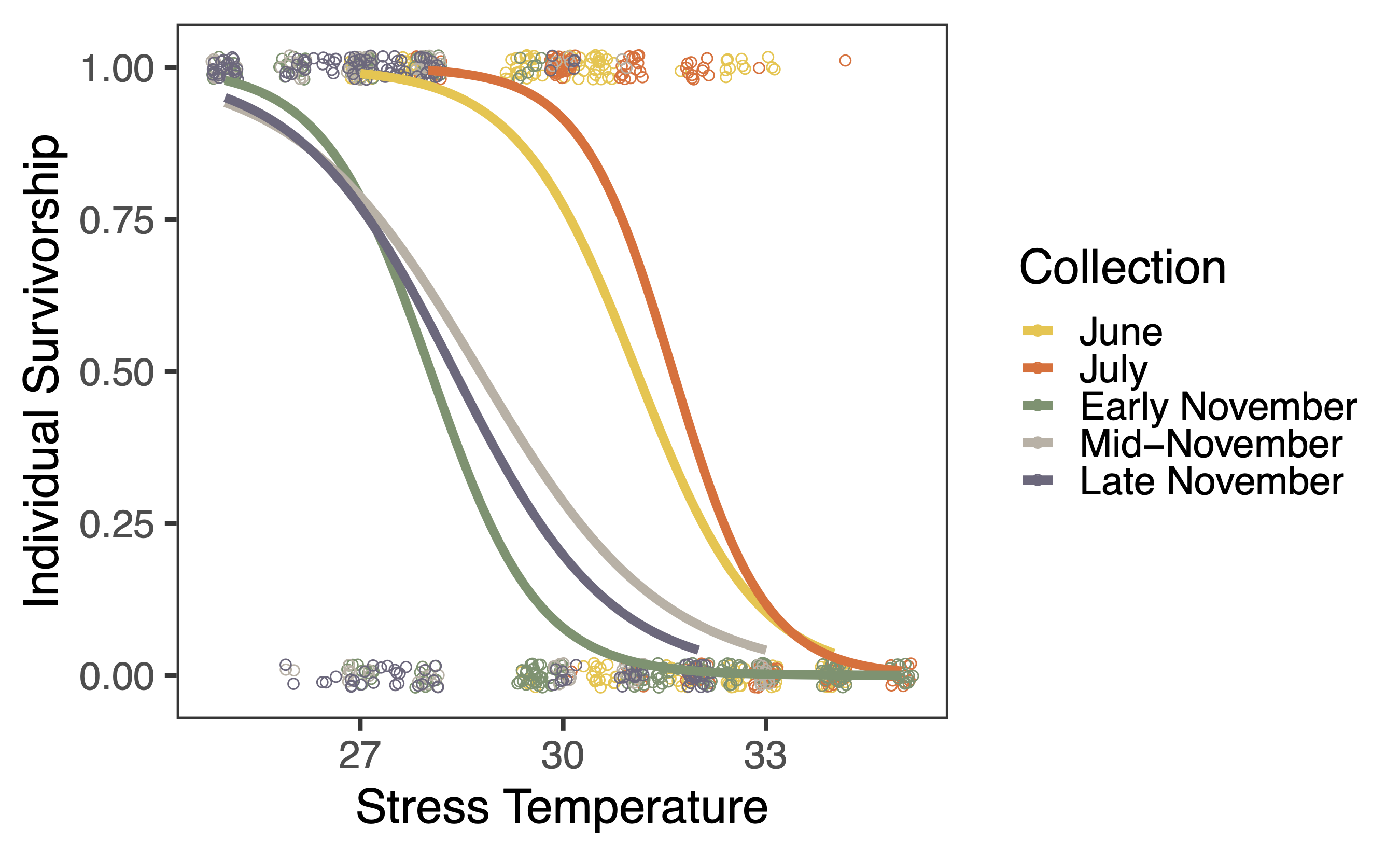
2019
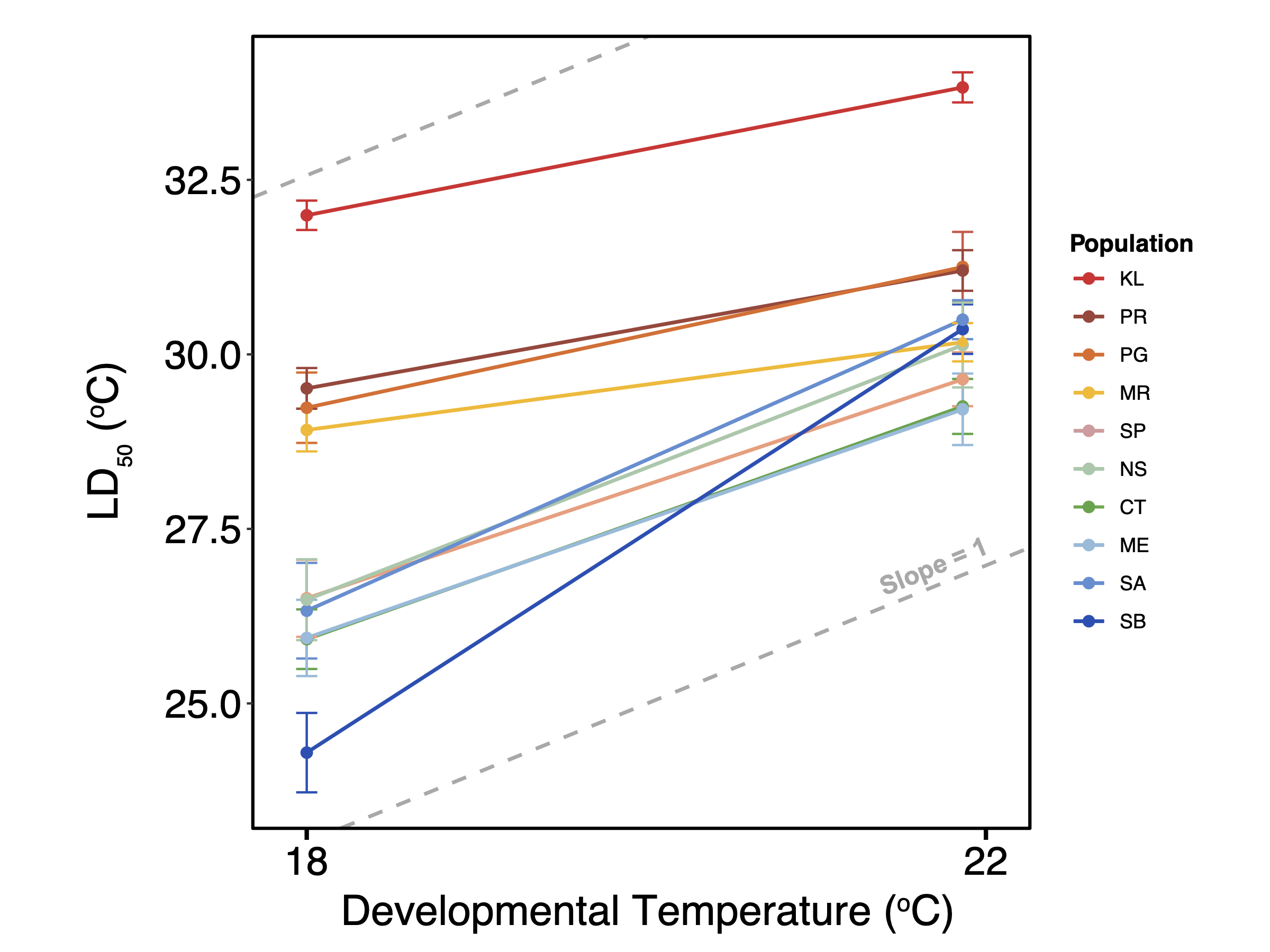
Sasaki, M. C. & H. G. Dam (2019) Integrating patterns of thermal tolerance and phenotypic plasticity with population genetics to improve understanding of vulnerability to warming in a widespread copepod. Global Change Biology, 25(12), 4147-4164.
Differences in population vulnerability to warming are defined by spatial patterns in thermal adaptation. These patterns may be driven by natural selection over spatial environmental gradients, but can also be shaped by gene flow, especially in marine taxa with high dispersal potential. Understanding and predicting organismal responses to warming requires disentangling the opposing effects of selection and gene flow. We begin by documenting genetic divergence of thermal tolerance and developmental phenotypic plasticity. Ten populations of the widespread copepod Acartia tonsa were collected from sites across a large thermal gradient, ranging from the Florida Keys to Northern New Brunswick, Canada (spanning over 20° latitude). Thermal performance curves (TPCs) from common garden experiments revealed local adaptation at the sampling range extremes, with thermal tolerance increasing at low latitudes and decreasing at high latitudes. The opposite pattern was observed in phenotypic plasticity, which was strongest at high latitudes. No relationship was observed between phenotypic plasticity and environmental variables. Instead, the results are consistent with the hypothesis of a trade-off between thermal tolerance and the strength of phenotypic plasticity. Over a large portion of the sampled range, however, we observed a remarkable lack of differentiation of TPCs. To examine whether this lack of divergence is the result of selection for a generalist performance curve or constraint by gene flow, we analyzed cytochrome oxidase I mtDNA sequences, which revealed four distinct genetic clades, abundant genetic diversity, and widely distributed haplotypes. Strong divergence in thermal performance within genetic clades, however, suggests that the pace of thermal adaptation can be relatively rapid. The combined insight from the laboratory physiological experiments and genetic data indicate that gene flow constrains differentiation of TPCs. This balance between gene flow and selection has implications for patterns of vulnerability to warming. Taking both genetic differentiation and phenotypic plasticity into account, our results suggest that local adaptation does not increase vulnerability to warming, and that low-latitude populations in general may be more vulnerable to predicted temperature change over the next century.
Sasaki, M.C., S. Hedberg†, K. Richardson†, & H.G. Dam (2019) Complex interactions between local adaptation, phenotypic plasticity, and sex affect vulnerability to warming in a widespread marine copepod. Royal Society open science, 6(3), 182115.
Predicting the response of populations to climate change requires an understanding of how various factors affect thermal performance. Genetic differentiation is well known to affect thermal performance, but the effects of sex and developmental phenotypic plasticity often go uncharacterized. We used common garden experiments to test for effects of local adaptation, developmental phenotypic plasticity and individual sex on thermal performance of the ubiquitous copepod, Acartia tonsa (Calanoida, Crustacea) from two populations strongly differing in thermal regimes (Florida and Connecticut, USA). Females had higher thermal tolerance than males in both populations, while the Florida population had higher thermal tolerance compared with the Connecticut population. An effect of developmental phenotypic plasticity on thermal tolerance was observed only in the Connecticut population. Our results show clearly that thermal performance is affected by complex interactions of the three tested variables. Ignoring sex-specific differences in thermal performance may result in a severe underestimation of population-level impacts of warming because of population decline due to sperm limitation. Furthermore, despite having a higher thermal tolerance, low-latitude populations may be more vulnerable to warming as they lack the ability to respond to increases in temperature through phenotypic plasticity.
2017
Pereira, R.J.*, M.C. Sasaki* , & R. Burton (2017) Adaptation to a latitudinal thermal gradient within a widespread copepod species: the contributions of genetic divergence and phenotypic plasticity. Proceedings of the Royal Society B: Biological Sciences, 284(1853), 20170236.
Understanding how populations adapt to heterogeneous thermal regimes is essential for comprehending how latitudinal gradients in species diversification are formed, and how taxa will respond to ongoing climate change. Adaptation can occur by innate genetic factors, by phenotypic plasticity, or by a combination of both mechanisms. Yet, the relative contribution of such mechanisms to large-scale latitudinal gradients of thermal tolerance across conspecific populations remains unclear. We examine thermal performance in 11 populations of the intertidal copepod Tigriopus californicus, ranging from Baja California Sur (Mexico) to British Columbia (Canada). Common garden experiments show that survivorship to acute heat-stress differs between populations (by up to 3.8°C in LD50 values), reflecting a strong genetic thermal adaptation. Using a split-brood experiment with two rearing temperatures, we also show that developmental phenotypic plasticity is beneficial to thermal tolerance (by up to 1.3°C), and that this effect differs across populations. Although genetic divergence in heat tolerance strongly correlates with latitude and temperature, differences in the plastic response do not. In the context of climate warming, our results confirm the general prediction that low-latitude populations are most susceptible to local extinction because genetic adaptation has placed physiological limits closer to current environmental maxima, but our results also contradict the prediction that phenotypic plasticity is constrained at lower latitudes.